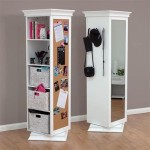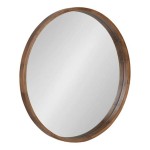Crafting a DIY Wooden Mirror Frame: A Comprehensive Guide
A mirror serves as a functional and decorative element in any living space. While mirrors are readily available in various styles, crafting a custom wooden frame offers a personalized touch, allowing for unique dimensions, finishes, and design aesthetics tailored to the homeowner's preference. This article provides a comprehensive guide to constructing a wooden mirror frame, outlining the necessary materials, tools, and step-by-step instructions involved in the process.
The appeal of a DIY wooden mirror frame lies in its adaptability. Homeowners can choose from a wide range of wood types, each possessing distinct grain patterns and characteristics. Pine, for instance, is a cost-effective and easily workable option, while hardwoods like oak or maple offer increased durability and aesthetic appeal. The frame's design can be further customized with various finishing techniques, including staining, painting, and distressing, enabling seamless integration with the existing decor.
Selecting Materials and Gathering Tools
The success of a DIY project hinges on the quality of materials and the availability of appropriate tools. For a wooden mirror frame, the following items are essential:
Wood: The choice of wood depends on the desired aesthetic, budget, and skill level. Pine is a popular choice for beginners due to its affordability and ease of cutting. Hardwoods such as oak, maple, or cherry offer enhanced durability and visual appeal but may require more advanced woodworking skills. Consider the dimensions of the mirror and the desired thickness of the frame when determining the amount of wood needed. It is generally recommended to purchase slightly more wood than calculated to account for potential errors or design changes.
Mirror: The mirror itself is, of course, the focal point of the project. Ensure accurate measurements of the mirror's dimensions, including length, width, and thickness. It is often prudent to purchase the mirror before beginning the frame construction to guarantee accurate fit and alignment. A local glass shop can cut a mirror to the precise specifications if a custom size is required.
Fasteners: The method of joining the frame pieces will determine the type of fasteners required. Options include wood glue, nails, screws, or a combination of these. Wood glue provides a strong, invisible bond, while nails and screws offer additional structural support. The selection of fasteners should align with the wood type and the desired level of durability.
Finishing Materials: These materials contribute to the frame's aesthetic appeal and protect the wood from moisture and wear. Options include wood stain, paint, varnish, polyurethane, or wax. The choice of finishing materials depends on the desired color, sheen, and level of protection. Consider applying a primer before painting to ensure optimal adhesion and coverage.
Tools: A comprehensive set of tools is essential for efficient and accurate frame construction. Key tools include a measuring tape, pencil, square, saw (hand saw, miter saw, or table saw), drill, sandpaper, clamps, and safety glasses. A miter saw is particularly useful for creating precise angled cuts, which are crucial for constructing the frame corners. Various grades of sandpaper are needed to smooth the wood surface before applying the finish.
Constructing the Frame
The construction process involves several key steps, each requiring precision and attention to detail.
Measuring and Cutting: Begin by carefully measuring the mirror's dimensions. Add the desired width of the frame to each side of the mirror to determine the overall dimensions of the frame. For example, if the mirror is 24 inches wide and 36 inches tall, and you want a 2-inch wide frame, the outer dimensions of the frame will be 28 inches wide and 40 inches tall. Using a square and pencil, mark the cutting lines on the wood according to the calculated dimensions. Employ a saw to cut the wood pieces to the marked lengths. If constructing a mitered frame, set the miter saw to a 45-degree angle and cut each end of the wood pieces accordingly. Ensure clean and precise cuts for optimal corner alignment.
Assembling the Frame: With the wood pieces cut to size, the next step is to assemble the frame. Apply wood glue to the mitered or butt joints, ensuring even coverage. Align the frame pieces carefully, ensuring that the corners are square. Secure the joints with clamps to hold the pieces in place while the glue dries. For added strength, consider using nails or screws to reinforce the glued joints. Predrill pilot holes to prevent the wood from splitting when using screws. Allow the glue to dry completely according to the manufacturer's instructions, typically for at least 24 hours.
Sanding and Finishing: Once the frame is assembled and the glue has dried, sand the entire surface to create a smooth and even texture. Begin with a coarser grit sandpaper (e.g., 120-grit) to remove any imperfections or rough edges, then gradually progress to finer grits (e.g., 220-grit and 320-grit) to achieve a polished finish. Pay particular attention to the corners and joints, ensuring a seamless transition between the frame pieces. After sanding, remove any dust with a tack cloth. Apply the desired finish to the frame, following the manufacturer's instructions. For stain, apply evenly with a brush or cloth, and wipe away any excess. For paint, apply multiple thin coats, allowing each coat to dry completely before applying the next. Consider applying a clear topcoat, such as varnish or polyurethane, to protect the finish and enhance its durability.
Securing the Mirror Within the Frame
The final step involves securely mounting the mirror within the frame.
Creating a Mounting Recess: The frame typically requires a rabbet or recess on the inside edge to accommodate the mirror. This can be achieved using a router with a rabbeting bit or by carefully chiseling out the wood. The depth of the rabbet should match the thickness of the mirror, allowing it to sit flush with the back of the frame. Ensure that the rabbet is wide enough to accommodate any clips or fasteners used to secure the mirror.
Using Mirror Clips or Glazing Points: Several methods can be used to secure the mirror within the frame. Mirror clips are small metal fasteners that attach to the frame and hold the mirror in place. They are typically screwed into the back of the frame, providing a secure and reliable hold. Glazing points are small triangular or diamond-shaped pieces of metal that are inserted into the back of the frame to hold the mirror in place. They are typically used in conjunction with a flexible sealant, such as silicone caulk, to create a watertight seal between the mirror and the frame. Apply the sealant to the rabbet before inserting the mirror, then insert the glazing points to hold the mirror in place while the sealant dries.
Alternative Mounting Methods: Other methods include using specialized mirror adhesive or creating a backing board to support the mirror. Mirror adhesive is a strong, permanent adhesive specifically designed for attaching mirrors to various surfaces. When using mirror adhesive, apply it sparingly to the back of the mirror, avoiding the edges. A backing board, typically made of plywood or hardboard, can be attached to the back of the frame to provide additional support for the mirror. The mirror can then be attached to the backing board using mirror adhesive or clips.
By following these detailed instructions, individuals can successfully construct a custom wooden mirror frame, adding a personalized and aesthetically pleasing touch to their living spaces. The project allows for creative expression in terms of wood selection, frame design, and finishing techniques, resulting in a unique and functional piece of home decor.

Easy Driftwood Mirror The Wood Grain Cottage

Diy Farmhouse Wood Frame Mirror She Gave It A Go
Diy Wood Frame Mirror Farmhouse Industrial Bathroom Joyfully Treasured

Wood Mirror Diy Shanty 2 Chic

Diy Farmhouse Wood Frame Mirror She Gave It A Go

Diy Wood Framed Bathroom Mirror Christina Maria Blog

Diy Framed Mirror Jaime Costiglio

Mirror Frame Diy How To Update A Basic Bathroom Our Faux Farmhouse

Diy Wood Mirror Frame Imperfectly Polished

Diy Rustic Wood Frame Mirror Amanda Katherine








